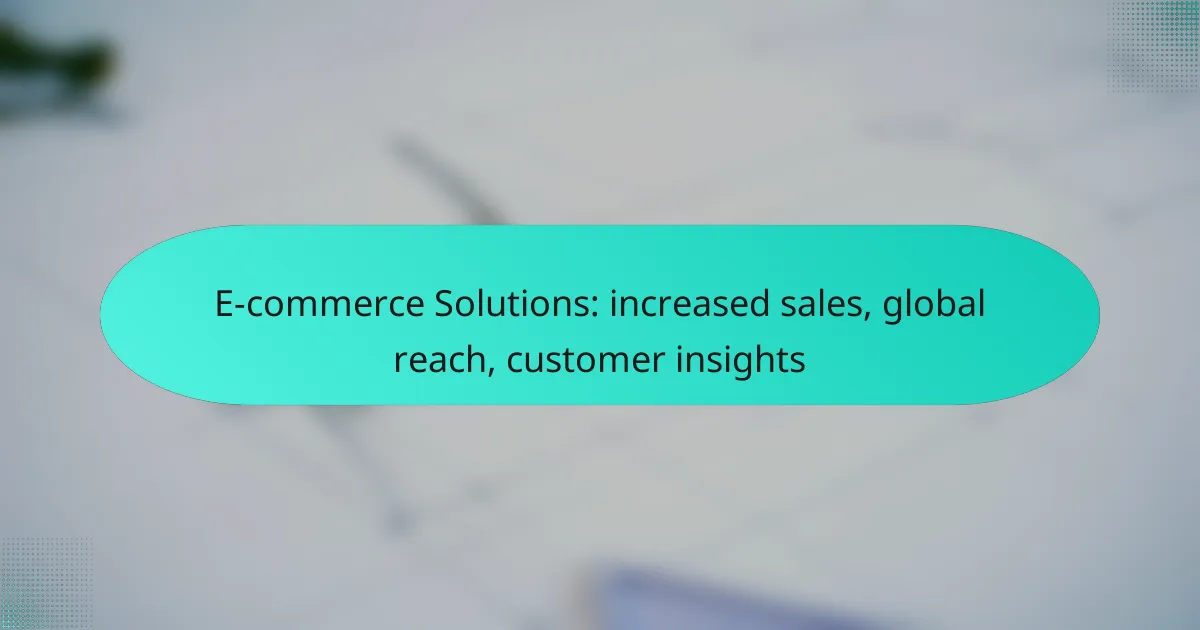E-commerce solutions offer businesses the opportunity to significantly increase sales by enhancing customer engagement and streamlining purchasing processes. With the ability to reach global markets, companies can expand their customer base and mitigate risks associated with local economies. Additionally, leveraging customer insights allows businesses to tailor their offerings and optimize marketing strategies, ultimately driving sales growth.

How can e-commerce solutions increase sales in Canada?
E-commerce solutions can significantly boost sales in Canada by enhancing customer engagement, streamlining purchasing processes, and providing valuable insights into consumer behavior. By implementing effective strategies, businesses can tap into the growing online market and improve their overall sales performance.
Personalized marketing strategies
Personalized marketing strategies involve tailoring promotions and communications to individual customer preferences and behaviors. This can be achieved through data analysis, allowing businesses to segment their audience and deliver targeted messages, which can increase conversion rates. For example, using customer purchase history to recommend products can lead to higher sales.
Consider utilizing email campaigns that address customers by name and suggest items based on their previous purchases. This approach can enhance customer loyalty and encourage repeat purchases, ultimately driving sales growth.
Optimized checkout processes
An optimized checkout process minimizes friction and enhances the user experience, leading to higher completion rates. Key elements include reducing the number of steps required to complete a purchase, offering multiple payment options, and ensuring the site is mobile-friendly. In Canada, supporting local payment methods like Interac can also be beneficial.
To improve the checkout experience, consider implementing features such as guest checkout, auto-fill for returning customers, and clear progress indicators. These adjustments can significantly reduce cart abandonment rates and increase overall sales.
Utilizing upselling techniques
Upselling techniques encourage customers to purchase higher-end products or add complementary items to their cart. This can be done through product recommendations displayed during the shopping process or at checkout. For instance, suggesting a premium version of a product or related accessories can effectively increase the average order value.
To implement upselling, ensure that the recommendations are relevant and provide clear value to the customer. Highlighting benefits or savings can make these offers more appealing and drive additional sales.
Implementing loyalty programs
Loyalty programs reward repeat customers, encouraging them to continue shopping with your brand. These programs can include points systems, discounts, or exclusive offers for members. In Canada, a well-structured loyalty program can enhance customer retention and increase lifetime value.
When designing a loyalty program, consider offering tiered rewards that incentivize higher spending. This can motivate customers to reach the next level for better benefits, ultimately boosting sales and fostering brand loyalty.
Leveraging social proof
Leveraging social proof involves using customer reviews, testimonials, and user-generated content to build trust and credibility. Positive feedback from previous buyers can significantly influence potential customers’ purchasing decisions. Displaying ratings and reviews prominently on product pages can enhance consumer confidence.
Encourage satisfied customers to leave reviews and share their experiences on social media. This not only provides valuable content for your site but also helps attract new customers, leading to increased sales through enhanced trust and visibility.

What are the benefits of global reach for e-commerce?
Global reach for e-commerce allows businesses to tap into international markets, expanding their customer base and increasing sales opportunities. This access not only enhances revenue potential but also mitigates risks associated with relying solely on local economies.
Access to international markets
Accessing international markets enables e-commerce businesses to sell products and services to customers worldwide. This requires understanding local regulations, payment methods, and shipping logistics. Companies can leverage platforms like Amazon or Shopify, which offer tools for global selling.
When entering new markets, consider local preferences and cultural nuances. Tailoring marketing strategies to resonate with different audiences can significantly improve engagement and conversion rates.
Diverse customer base
A diverse customer base enhances a company’s resilience against market fluctuations. By attracting customers from various regions, businesses can reduce the impact of local economic downturns. This diversity also fosters innovation, as different perspectives can lead to new product ideas and improvements.
To effectively reach a diverse audience, businesses should invest in multilingual support and localized content. This ensures that marketing messages are culturally relevant and accessible to all potential customers.
Increased revenue potential
Global reach significantly increases revenue potential by opening up new sales channels. Businesses can capitalize on higher demand for certain products in foreign markets, often leading to increased profit margins. For instance, luxury goods may see higher sales in markets with growing middle classes.
To maximize revenue, consider pricing strategies that reflect local purchasing power. This may involve adjusting prices based on currency fluctuations and local competition to remain attractive to consumers.
Reduced dependency on local economy
Expanding into global markets reduces dependency on the local economy, providing a buffer against regional economic challenges. Businesses that diversify their market presence are better positioned to withstand local downturns and shifts in consumer behavior.
To mitigate risks, regularly assess the economic conditions of all markets you operate in. This proactive approach allows businesses to adapt strategies quickly, ensuring continued growth despite local economic changes.

How can customer insights enhance e-commerce strategies?
Customer insights can significantly enhance e-commerce strategies by informing decision-making and optimizing marketing efforts. By understanding customer preferences and behaviors, businesses can tailor their offerings, improve user experience, and ultimately increase sales.
Data analytics tools
Data analytics tools are essential for gathering and interpreting customer insights. These tools can analyze purchasing patterns, website traffic, and customer demographics, providing valuable information that can guide marketing strategies. Popular options include Google Analytics, Adobe Analytics, and various e-commerce platforms that offer built-in analytics features.
When choosing a data analytics tool, consider factors such as ease of use, integration capabilities, and the specific metrics you want to track. Regularly reviewing analytics reports can help identify trends and areas for improvement, allowing for timely adjustments to your e-commerce strategy.
Customer feedback mechanisms
Implementing customer feedback mechanisms allows businesses to gather direct insights from their audience. Surveys, reviews, and feedback forms can provide qualitative data on customer satisfaction and product performance. Tools like SurveyMonkey or Typeform can help create effective surveys that yield actionable insights.
Encouraging customers to leave feedback post-purchase can enhance the quality of insights collected. Make the process simple and accessible, and consider offering incentives, such as discounts on future purchases, to increase participation rates.
Behavioral tracking technologies
Behavioral tracking technologies monitor how customers interact with your website, providing insights into user behavior. Tools like heatmaps, session recordings, and click tracking can reveal which areas of your site attract attention and which may need improvement. Solutions such as Hotjar or Crazy Egg are popular for this purpose.
Utilizing these technologies can help identify bottlenecks in the customer journey, allowing for targeted optimizations. Ensure compliance with privacy regulations, such as GDPR, when implementing tracking technologies to maintain customer trust.
Segmentation for targeted marketing
Segmentation involves dividing your customer base into distinct groups based on shared characteristics or behaviors. This allows for more targeted marketing efforts, ensuring that messages resonate with specific audiences. Common segmentation criteria include demographics, purchase history, and engagement levels.
By tailoring marketing campaigns to different segments, businesses can improve conversion rates and customer loyalty. Utilize email marketing platforms that support segmentation, such as Mailchimp or Klaviyo, to efficiently manage and execute targeted campaigns.

What criteria should be considered when selecting e-commerce solutions?
When selecting e-commerce solutions, consider factors such as scalability, integration capabilities, and user experience. These criteria ensure that the platform can grow with your business, work seamlessly with existing systems, and provide a positive shopping experience for customers.
Scalability of the platform
Scalability refers to the platform’s ability to handle increased traffic and sales volume as your business grows. A scalable solution can accommodate fluctuations in demand without compromising performance or user experience.
Look for platforms that offer flexible pricing models and can support a growing catalog of products. For instance, a solution that allows you to upgrade your hosting plan or add features as needed can save you from costly migrations later.
Integration capabilities with existing systems
Integration capabilities are crucial for ensuring that your e-commerce platform works well with your current systems, such as inventory management, CRM, and payment gateways. A solution that offers robust APIs and pre-built connectors can streamline operations and reduce manual data entry.
Evaluate the ease of integration with your existing tools. For example, if you use a specific accounting software, ensure that the e-commerce solution can connect with it seamlessly to maintain accurate financial records.
User experience and interface
User experience (UX) and interface design significantly impact customer satisfaction and conversion rates. A well-designed platform should be intuitive, allowing customers to navigate easily and complete purchases without frustration.
Consider the mobile responsiveness of the platform, as a significant portion of online shopping occurs on mobile devices. Test the interface for speed and ease of use, ensuring it provides a seamless experience across different devices and browsers.

Which e-commerce platforms are popular in Canada?
In Canada, popular e-commerce platforms include Shopify and WooCommerce, which cater to various business needs and sizes. These platforms offer unique features that help businesses increase sales, reach global markets, and gain customer insights.
Shopify
Shopify is a leading e-commerce platform in Canada, known for its user-friendly interface and robust features. It allows businesses to set up online stores quickly, with customizable templates and integrated payment options, making it suitable for both small and large enterprises.
One of Shopify’s key advantages is its scalability. As a business grows, Shopify can accommodate increased traffic and sales without significant technical adjustments. Additionally, it offers various apps and plugins to enhance functionality, such as inventory management and marketing tools.
When using Shopify, consider the transaction fees associated with different payment gateways. While Shopify Payments has no additional fees, third-party gateways may incur charges. It’s essential to evaluate these costs against your expected sales volume.
WooCommerce
WooCommerce is a flexible e-commerce solution that operates as a plugin for WordPress, making it a popular choice for businesses already using this content management system. It offers extensive customization options and is ideal for those who want more control over their online store’s design and functionality.
With WooCommerce, businesses can benefit from a wide range of themes and plugins, allowing for tailored features such as subscription services or product variations. However, it requires a bit more technical knowledge to set up and manage compared to Shopify.
When choosing WooCommerce, ensure that you have a reliable hosting provider, as performance can vary significantly based on server quality. Additionally, keep in mind that while WooCommerce is free, costs can accumulate through premium themes, plugins, and hosting services.
